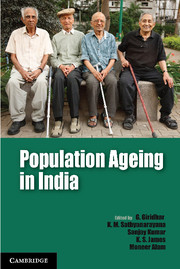Book contents
- Frontmatter
- Contents
- List of Figures
- List of Tables
- Preface
- Acknowledgements
- Introduction
- 1 Demographics of Population Ageing in India
- 2 Elderly Workforce Participation, Wage Differentials and Contribution to Household Income
- 3 Living Arrangements of Elderly in India: Policy and Programmatic Implications
- 4 Health Status of Elderly in India: Trends and Differentials
- 5 The National Policy for Older Persons: Critical Issues in Implementation
- 6 Policy Initiatives on Population Ageing in Select Asian Countries and Their Relevance to the Indian Context
- 7 Studies on Ageing in India: A Review
- Contributors
- Index
Introduction
Published online by Cambridge University Press: 05 August 2014
- Frontmatter
- Contents
- List of Figures
- List of Tables
- Preface
- Acknowledgements
- Introduction
- 1 Demographics of Population Ageing in India
- 2 Elderly Workforce Participation, Wage Differentials and Contribution to Household Income
- 3 Living Arrangements of Elderly in India: Policy and Programmatic Implications
- 4 Health Status of Elderly in India: Trends and Differentials
- 5 The National Policy for Older Persons: Critical Issues in Implementation
- 6 Policy Initiatives on Population Ageing in Select Asian Countries and Their Relevance to the Indian Context
- 7 Studies on Ageing in India: A Review
- Contributors
- Index
Summary
India is experiencing unprecedented demographic changes in recent times with wide implications for the future. Undoubtedly, such changes will alter the composition of the population in the coming years. The proportion of elderly is on a rapid increase and will continue to in the future as well. Currently the growth rate of elderly population is three times higher than the overall population clearly implying that ageing of the population will be the major challenge in India for the coming decades. In addition, all the states in the country are currently experiencing rapid fertility changes resulting in fewer and fewer children born in the country. The result from the 2011 census also reveals a decline in the child population. This is for the first time in the country that the number of children in the 0–6 age group has registered negative growth in the independent India (Census of India, 2011a). This is expected to alter the age composition significantly in the coming decades.
The data from 2011 census revealed that there are 104 million elderly in the country constituting 8.6 per cent of the population (Census of India, 2011b). The United Nation Population Division has projected that elderly population will reach 11 per cent by 2025 (United Nations Population Division, 2013). India is expected to have around 157 million elderly 60 years and above by then. This number will nearly double to around 297 million by 2050 constituting 18 per cent of India's population.
- Type
- Chapter
- Information
- Population Ageing in India , pp. xvii - xxviPublisher: Cambridge University PressPrint publication year: 2014



